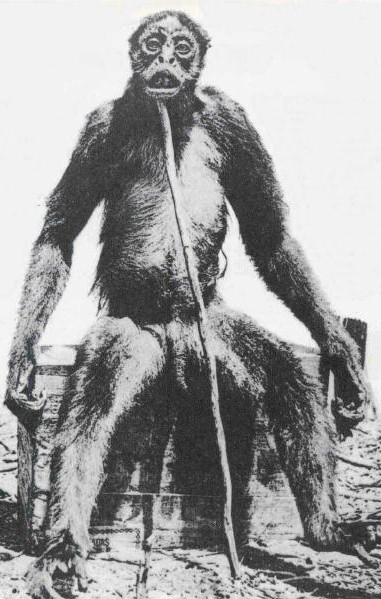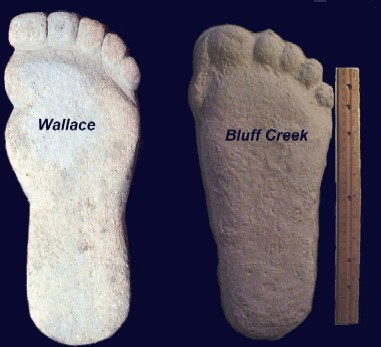
August 20, 2008

The cropped photograph of the so-called Ameranthropoides loysi, de Loys’ alleged "ape," one of the most sinister hoaxes of all times (see #10 below).
In light of the Georgia Bigfoot Freezergate hoax (credit: Bobbie Short), I thought it might be a good idea to re-visit something I wrote in 2006. You will notice, in the examples below, there lurks in the shadows one that points to Tom Biscardi’s historical impact and another that details his old associate, Ivan Marx.
There are scores of motives for hoaxes. Here are a few that I think should float to the surface of any cesspool filled with this stuff.
My choices for the top ten major reasons that exist for hoaxing in cryptozoology are:
1.) Fiscal gain (e.g. allegedly the reason behind a hoaxster’s "Coast to Coast AM" radio appearances was so the guest’s broadcast claims of a "captured Bigfoot" video he said was going to post online would encourage "subscribers" to pay a fee to "see" it; the fact he did not deliver did not mean he ever gave the money back, allegedly; psychologically these individuals rarely admit guilt, but say they were “hoodwinked”);
2.) Fifteen minutes of fame (e.g. the late Ivan Marx, the late Ray Wallace, and other members of the alleged Bigfoot hoaxing fraternity appear to have had a psychological need for media-attention, mostly gained by allegedly producing false evidence);
3.) Pranks (i.e., these can be harmless teen, college or Halloween-style ones that go overboard and become local legends);
4.) Spreading misinformation (e.g. when I was doing research for Cryptozoology A to Z, an individual attempted to create an online history of sightings about the so-called "Ozark Howler," so I would write an entry on them in my forthcoming book; his deception was discovered and not one paragraph exists therein on that fake cryptid);
5.) Vandalism (i.e,. some hoaxing appears to be mischief, performed for psychological reasons only known to the creator, to cause disruptions for disruptions’ sake, in a display of misguided graps at power in a powerless or mentally unbalanced person; some have called these purely "evil" acts);
6.) Venting of anger or revenge targeting a specific group or individuals (i.e., a few manufactured events are private personalized incidents that may get incidental local or national media attention, although the original non-media motive may be lost in the publicity that results);
7.) Private exchanges gone bad (i.e., related to bragging, hoaxing, and pranks that spreads beyond a small circle of friends and foes, such as the faking of some Bigfoot prints in the Pacific Northwest by the late Ray Wallace and the late Rant Mullens may be partially laid to this motive, regarding their competitive membership in a "Liars Club")

8.) Misinterpreted jokes (e.g. these are funny gags that are misunderstood by others – botched – as discussing reality, discovered to be fiction, and thus have been labeled a hoax, perhaps inappropriately);
9.) Discrediting or promoting a company or an individual (i.e. these appear to be different than #6 above in that the public media factor is built into the hoax, on purpose; virtual marketing falls under this section); and
10.) Political reasons (e.g. the racism behind the photographs of spider monkeys taken by François De Loys in 1920 in Venezuela that have been passed off as unknown apes; the hoax was to support the eugenics theories of George Montandon, who was looking for an anthropoid precursor for the Native South Americans, just as he had said Africans evolved from gorillas and Asians from orangutans*; his theories were linked to the same ideas that the Nazis used against the Jewish, Roma people and other populations during the Holocaust).
De Loys’ "ape" is nothing more than a spider monkey, similar to the one pictured above, which you may enlarge by clicking on the image.
* "De Loys’s Photograph: A Short Tale of Apes in Green Hell, Spider Monkeys, and Ameranthropoides loysi as Tools of Racism" by Loren Coleman and Michel Raynal, in The Anomalist 4, Autumn 1996.
"Loren’s Top 10 Reasons For Cryptozoology Hoaxes" © Loren Coleman 2006.
About Loren Coleman
Loren Coleman is one of the world’s leading cryptozoologists, some say “the” leading living cryptozoologist. Certainly, he is acknowledged as the current living American researcher and writer who has most popularized cryptozoology in the late 20th and early 21st centuries.
Starting his fieldwork and investigations in 1960, after traveling and trekking extensively in pursuit of cryptozoological mysteries, Coleman began writing to share his experiences in 1969. An honorary member of Ivan T. Sanderson’s Society for the Investigation of the Unexplained in the 1970s, Coleman has been bestowed with similar honorary memberships of the North Idaho College Cryptozoology Club in 1983, and in subsequent years, that of the British Columbia Scientific Cryptozoology Club, CryptoSafari International, and other international organizations. He was also a Life Member and Benefactor of the International Society of Cryptozoology (now-defunct).
Loren Coleman’s daily blog, as a member of the Cryptomundo Team, served as an ongoing avenue of communication for the ever-growing body of cryptozoo news from 2005 through 2013. He returned as an infrequent contributor beginning Halloween week of 2015.
Coleman is the founder in 2003, and current director of the International Cryptozoology Museum in Portland, Maine.
Filed under Bigfoot, Conspiracies, Cryptomundo Exclusive, Cryptotourism, CryptoZoo News, Cryptozoologists, Cryptozoology, Evidence, Expedition Reports, Eyewitness Accounts, Hoaxes, Media Appearances, Pop Culture